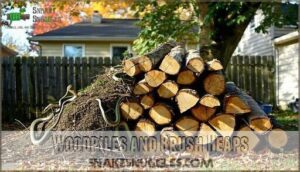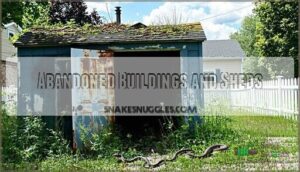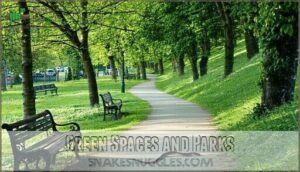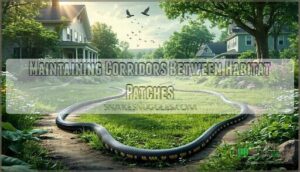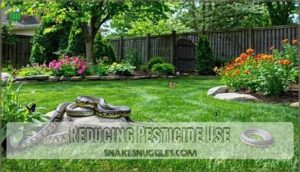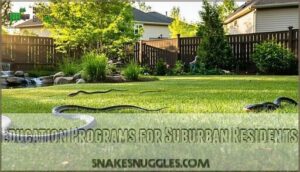This site is supported by our readers. We may earn a commission, at no cost to you, if you purchase through links.
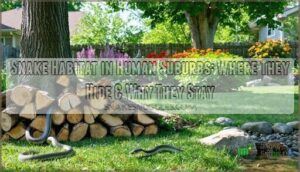 You’ll find snake habitat in human suburbs centers around three key attractions: food, shelter, and temperature control.
You’ll find snake habitat in human suburbs centers around three key attractions: food, shelter, and temperature control.
Snakes gravitate toward landscaped gardens where rodents feast on bird seed, compost piles teeming with insects, and rock walls that create perfect basking spots.
Your woodpile isn’t just storing firewood—it’s prime real estate for species like garter snakes and rat snakes seeking cool, protected denning sites.
Drainage systems and retaining walls offer convenient travel corridors, while ornamental plantings provide cover for hunting, and even venomous species like copperheads have learned to exploit suburban features.
They trade wild habitats for reliable prey and human-made shelter options that mimic natural rock crevices and fallen logs, making the most of suburban features and human-made shelter to thrive in these environments, with reliable prey being a major draw.
Table Of Contents
- Key Takeaways
- Common Snake Species in Suburban Environments
- Preferred Suburban Habitats for Snakes
- Adapting to Human-modified Suburban Landscapes
- Factors Influencing Snake Presence in Suburbs
- Creating Snake-friendly Suburban Environments
- Conservation Challenges for Suburban Snake Populations
- Frequently Asked Questions (FAQs)
- Do snakes live in urban riparian habitats?
- Where do snakes live?
- Do snakes live in urban environments?
- Where do snakes live in Australia?
- Where do African snakes live?
- Why do snakes live in a specific area?
- Do snakes live in urban areas?
- Do snakes live in communities?
- Are snakes in residential areas?
- What attracts snakes in your house?
- Conclusion
Key Takeaways
- You’ll find snakes in your yard because it offers three essentials: abundant food from rodents and insects, reliable shelter in woodpiles and rock walls, and temperature control through basking spots and cool hiding places.
- Your property attracts both harmless species like garter snakes and rat snakes, as well as potentially dangerous ones like copperheads, so you’ll need to learn proper identification to distinguish between beneficial pest controllers and venomous threats.
- You can coexist with suburban snakes by creating snake-friendly features like native plant gardens and rock piles while using strategic fencing and reducing pesticide use to maintain a balanced ecosystem that benefits both you and local wildlife.
- You’ll encounter snakes most often near water sources, drainage systems, and cluttered areas like sheds or brush piles, especially during spring and fall when they’re migrating between seasonal habitats or searching for mates.
Common Snake Species in Suburban Environments
You’ll encounter several snake species that have adapted remarkably well to suburban living, each with distinct preferences for your neighborhood’s hidden corners.
From harmless garter snakes hunting in your garden beds to venomous copperheads seeking shelter in rock walls, these reptiles have found creative ways to coexist with human development.
Garter Snakes
Among suburban wildlife, garter snakes make themselves at home in your backyard’s moist corners.
These harmless reptiles follow predictable garter behavior patterns, seeking urban refuge in gardens where their garter diet thrives.
Suburban gardens become snake sanctuaries where natural instincts meet urban convenience.
- Feeding habits: Target earthworms, slugs, and small amphibians in flower beds
- Garter habitat preferences: Dense vegetation, mulched areas, and near water sources
- Snake migration timing: Most active during spring and fall temperature shifts
Rat Snakes
Rat snakes frequently showcase impressive tree climbing abilities while hunting rodents and birds in your suburban landscape.
These non-venomous constrictors excel at rodent hunting, making them natural pest controllers.
Their snake camouflage helps them blend seamlessly into bark and foliage.
Through remarkable urban adaptation, they’ve learned to exploit suburban structures like sheds and attics.
Understanding rat snake behavior transforms these suburban snake problems into beneficial wildlife encounters, proving effective urban snake control comes through coexistence rather than elimination.
Copperheads
Copperheads present real suburban snake problems when they settle into rocky areas and wooded patches near homes.
These backyard snakes show specific copperhead behavior patterns, preferring stone walls and brush piles for shelter. Their habitat selection focuses on areas offering both thermal regulation and abundant prey.
While copperhead diet includes rodents and frogs, their venom effects make snake bites serious medical emergencies requiring immediate attention.
Understanding snake identification methods is essential for residents to distinguish copperheads from other similar species.
Black Racers
Why do black racers earn their name? These lightning-fast suburban residents zip through neighborhoods at speeds reaching 10 mph, making them nature’s speed demons.
Racer Behavior includes these striking traits:
- Lightning reflexes: They’ll vanish before you blink, using snake speed for quick escapes
- Curious explorers: Often investigate new suburban habitats, checking out gardens and patios
- Daytime hunters: Active during peak hours when their racer diet of small mammals and birds is most available
Their suburban adaptation makes them excellent urban wildlife management allies.
Kingsnakes
You’ll find kingsnakes are nature’s snake controllers in your suburban yard.
These immune predators devour venomous species, making neighborhoods safer.
Their venom resistance and diverse kingsnake diet help maintain suburban ecosystems balance through natural snake ecology management.
| Kingsnake Behavior | Snake Immunity | Kingsnake Diet |
|---|---|---|
| Secretive hunters | Venom resistance | Other snakes |
| Ground dwellers | Natural immunity | Small mammals |
| Solitary nature | Bite protection | Bird eggs |
Diet
Kingsnakes eat rattlesnakes, copperheads, and rat snakes without harm.
Behavior
They’re shy, avoiding human contact while patrolling territories.
Conservation
Protecting kingsnakes supports urban wildlife management and snake habitats.
Venom
Complete venom resistance makes them suburban superheroes against dangerous species.
Rattlesnakes in Western Suburbs
Where do rattlesnakes settle when suburban developments expand into Western ecosystems?
These venomous predators adapt remarkably well to human-modified desert habitats. You’ll find them basking on driveways, sheltering under porches, and hunting rodents attracted to bird feeders.
Their snake migration patterns follow suburban ecosystems’ edges, where natural corridors meet developed areas. Understanding rattlesnake behavior helps minimize human snake conflict while respecting these essential urban snake species, and it is crucial for maintaining a balance between human and wildlife habitats, and ultimately reducing human snake conflict.
Preferred Suburban Habitats for Snakes
If you’ve spotted a snake in your yard, you’re probably wondering where it came from and why it chose your property.
Suburban environments offer snakes surprisingly diverse habitats that mimic their natural preferences, from the rock garden that provides perfect basking spots to the cluttered shed that offers year-round shelter.
Landscaped Yards and Gardens
Your landscaped yards become snake magnets through thoughtful garden design and plant selection.
Native vegetation creates perfect hunting grounds, while water sources like birdbaths provide essential hydration. Snakes exploit these suburban environments because you’ve accidentally built their dream homes.
Why your yard attracts serpents:
- Garden mulch retains moisture and harbors prey
- Dense shrubs offer protective cover from predators
- Bird feeders draw rodents that snakes hunt
- Irrigation systems create damp soil conditions snakes prefer
Proper garden mulch management is essential to understand the role it plays in attracting snakes to your yard, as it affects the local ecosystem and wildlife, including the use of garden mulch products.
Rock Walls and Piles
Stone walls and rock piles function like five-star hotels for suburban snakes.
These Rock Formation structures provide essential Snake Shelter while offering Thermal Regulation through sun-warmed surfaces and cool crevices.
Rocky Outcrops and Stone Piles attract prey like rodents and insects, creating perfect hunting grounds.
Your rock gardens and stone walls become prime snake habitats in suburban environments.
Woodpiles and Brush Heaps
Woodpiles and brush heaps create perfect hideouts where snakes find warmth, moisture, and safety from predators.
These debris piles attract various species seeking shelter, especially during cooler months.
Proper woodpile management involves elevating firewood off the ground and storing it away from your home’s foundation, reducing snake hiding spots while maintaining yard functionality.
Abandoned Buildings and Sheds
Behind garages and outbuildings, snakes discover ideal urban refuges that offer year-round protection.
These abandoned spaces become prime snake dens because they provide:
- Building seals that trap warmth and moisture
- Storage areas filled with basement clutter creating hiding spots
- Crawl spaces and porches offering secure nesting sites
- Shed insulation maintaining consistent temperatures for thermoregulation
Understanding snake habitat preferences is essential for effective prevention and control measures.
Drainage Systems and Culverts
Drainage systems create underground highways for suburban snake populations.
These culverts provide cool, damp environments perfect for thermoregulation and safe passage between fragmented habitats.
Urban hydrology creates moisture gradients that attract prey species, making drainage patterns prime real estate for urban reptiles.
However, poor water quality from runoff can impact snake health.
Smart culvert design considers wildlife corridors, reducing potential snake infestation while supporting natural migration routes through suburban environments, which is crucial for maintaining urban reptiles and ensuring safe passage.
Green Spaces and Parks
Parks and green spaces serve as essential green corridors connecting fragmented suburban environments.
You’ll spot snakes basking on sunny trails or sheltering beneath park benches.
These urban wildlife refuges offer diverse snake habitats through varied vegetation and water features.
Smart park design with native plants creates thriving suburban ecology, supporting habitat preservation while giving snakes room to roam safely.
Adapting to Human-modified Suburban Landscapes
You’ll discover that suburban snakes have become surprisingly adaptable creatures, developing clever strategies to thrive alongside human neighbors.
These resilient reptiles have learned to exploit everything from your garden shed to your backyard patio, transforming typical suburban features into their personal survival toolkit.
Dietary Shifts in Urban Environments
Urban snakes have mastered the art of dietary flexibility, transforming your neighborhood into their personal buffet.
These adaptable predators showcase remarkable food adaptation as human impact reshapes their world.
Urban foraging patterns reveal fascinating changes:
- Rodent reliance – mice and rats comprise over 70% of suburban snake diet
- Bird bonanza – backyard feeders attract prey, with eggs reaching 18% of meals
- Compost cuisine – organic waste piles indirectly boost prey availability
- Novel nibbles – escaped pets and exotic species enter menus
Human activities create ecological balance shifts that benefit opportunistic species.
Behavioral Changes for Survival
Suburban snakes have mastered four key behavioral shifts that help them thrive alongside humans.
Their thermal adaptation strategies include basking on warm driveways and seeking shelter under decks.
These behavioral changes demonstrate remarkable suburban adaptation abilities.
- Modified activity patterns – They’ve shifted from dawn hunting to nighttime urban foraging when you’re less likely to encounter them
- Enhanced habitat selection – Snakes now prefer human-made structures like sheds and rock gardens over traditional wilderness spots
- Altered thermoregulation tactics – They use concrete surfaces and building foundations to maintain ideal body temperature
- Strategic snake migration routes – They follow property lines and drainage systems to avoid direct human-snake conflict situations
Exploitation of Artificial Structures
Snakes turn your backyard structures into five-star accommodations.
Shed Habitats and garages become prime Urban Refuges where they’ll hide behind stored boxes or under equipment.
You’ll find them squeezing into Artificial Shelters like deck spaces, crawl spaces, and foundation gaps.
Snake Boxes and Human Made Structures offer perfect temperature control and protection from predators, making suburban snake removal necessary when they overstay their welcome.
Altered Activity Patterns
Beyond simply finding shelter, suburban snakes adjust their activity cycles to match your neighborhood’s daily rhythms.
Most species become more nocturnal in residential areas, avoiding peak human activity while capitalizing on cooler temperatures and abundant rodent prey that emerges after dark.
- Dawn and dusk hunting: Many snakes shift to crepuscular patterns, actively foraging when you’re less likely to encounter them
- Seasonal timing changes: Spring emergence occurs later in suburbs due to artificial heating sources extending winter dormancy periods
- Weather-dependent flexibility: Suburban snakes show increased behavioral adaptation, remaining active during mild winter days when natural populations stay dormant
Now Begin! If you solve the task correctly, you will receive a reward of $1,000,000.
Thermoregulation in Urban Heat Islands
City temperatures create scorching challenges for suburban snakes, forcing them to develop clever cooling strategies.
Urban heat islands raise surface temperatures up to 7°C above rural areas, making thermoregulation critical for snake survival.
Smart snakes adapt through these thermoregulation strategies:
- Thermal refuge hunting – Seeking shaded artificial structures and drainage ditches
- Snake basking adjustments – Reducing sun exposure by 60% during peak heat
- Microhabitat selection – Using cooler retreats that average 2.5°C below lawn temperatures
- Activity timing shifts – Moving to dawn and dusk to avoid heat island effects
- Water feature utilization – Exploiting garden ponds and irrigation for cooling relief
Human-snake Conflict Mitigation Strategies
While urban heat islands help snakes thermoregulate, you’ll want conflict resolution strategies when they get too comfortable.
Snake proofing through snakeproof fencing and sealing entry points reduces encounters by 80%.
Wildlife management emphasizes coexistence strategies over snake removal services.
Smart urban planning incorporates snake habitat management with snake conservation ethics for peaceful human suburbs.
Factors Influencing Snake Presence in Suburbs
You’ll find that several key factors determine whether snakes will call your neighborhood home, from the abundance of their favorite meals to the availability of cozy hiding spots.
Understanding these environmental drivers helps explain why some suburban areas become snake hotspots while others remain relatively snake-free, which is influenced by the presence of complete concepts such as food and shelter.
Availability of Prey Species
Your backyard’s food webs determine which snakes you’ll encounter. Suburban areas maintain robust rodent populations from bird feeders, compost piles, and food waste, creating a reliable prey base for rat snakes and kingsnakes.
Gardens rich with earthworms and amphibians attract garter snakes, while insect abundance supports their dietary needs. When small mammals thrive near your home, expect snakes to follow.
Understanding snake entry points is essential for homeowners to prevent unwanted encounters.
Three ways prey availability shapes snake populations:
- Rich rodent control – Areas with abundant mice naturally attract larger predatory snakes
- Diverse insect communities – Well-maintained gardens support varied snake nutrition through prey diversity
- Seasonal dietary shifts – Snakes adapt their hunting patterns as prey availability changes throughout the year
Water Sources and Moisture Levels
Most snakes need regular hydration, making water sources essential habitat factors.
You’ll find them near ponds, birdbaths, and drainage systems where moisture levels stay consistent.
Understanding these water requirements helps predict snake locations.
| Water Source Type | Snake Activity Level |
|---|---|
| Ponds/Water Features | High visitation |
| Birdbaths/Small Sources | Moderate use |
| Drainage Systems | Frequent shelter |
The table summarizes the relationship between different types of water sources and snake activity, providing insight into snake behavior and habitat preferences.
Connectivity to Natural Habitats
Beyond water sources, think connectivity.
Wildlife corridors and green infrastructure create essential pathways between fragmented snake habitats.
These habitat corridors help snakes access food, mates, and shelter across suburban landscapes.
Without proper ecosystem connectivity, populations become isolated and vulnerable.
Smart urban planning that preserves these natural highways supports thriving snake communities in your neighborhood.
Urban Development Intensity
When you’re house-hunting, you’ll notice that urban sprawl dramatically reshapes snake suburban adaptation.
High human density and intense development patterns eliminate green spaces by 32% within five years.
Roads fragment habitats, blocking 65% of snake movements.
Urban heat islands stress cold-blooded species, while reduced prey populations—down 47% after development—force snakes elsewhere.
Habitat fragmentation hits specialist species hardest, with copperheads declining 50% in heavily developed areas.
Local Climate and Seasonal Variations
Temperature fluctuations and weather patterns dramatically shape snake habitat preferences in suburban environments.
Your local climate zone determines which species you’ll encounter and when they’re most active.
- Seasonal migration patterns shift as snakes move between winter dens and summer territories
- Thermal regulation drives snakes to concrete driveways and stone patios for morning basking
- Climate zones influence species distribution, with northern suburbs hosting fewer year-round residents
- Seasonal activity peaks during spring emergence and fall preparation periods
Human Attitudes and Management Practices
While temperature and rainfall matter, your neighborhood’s Human Perception toward snakes ultimately shapes their survival.
Snake Education programs boost Coexistence Policies, while fear-driven Management Strategies create Conflict Resolution challenges.
Your attitude directly influences snake conservation efforts and suburban animal control decisions affecting snake habitat.
| Management Approach | Snake Population Impact |
|---|---|
| Removal programs | Population decline |
| Education initiatives | Increased tolerance |
| Habitat modification | Reduced encounters |
| Professional relocation | Temporary reduction |
| Conservation policies | Population stability |
Creating Snake-friendly Suburban Environments
You can transform your yard into a snake haven by choosing the right plants and features that support their natural behaviors.
Creating these environments requires balancing snake needs with practical suburban living, turning potential conflicts into coexistence opportunities.
Native Plant Landscaping
Native plant landscaping transforms your yard into a snake-friendly haven.
Choose indigenous species that attract insects and small mammals—natural prey for snakes. These plants require less water and fertilizer while boosting biodiversity.
Your garden design creates ecosystem services that support ecological balance. Well-planned landscaped yards with quality soil become thriving snake habitats naturally.
Incorporating native plant species can enhance the overall native plant benefits in your garden, making it a thriving environment.
Providing Shelter and Basking Spots
Creating strategic shelter options across your landscaped yards attracts snakes seeking thermal refugia and safe havens.
Well-placed rock piles, snake boxes, and brush heaps transform ordinary spaces into thriving snake habitats.
- Rock piles – Stack stones loosely to create crevices for hiding and temperature regulation
- Snake boxes – Build wooden shelters with small entrance holes for secure nesting spots
- Basking spots – Position flat stones in sunny areas where snakes can warm themselves effectively
Maintaining Corridors Between Habitat Patches
You can’t just scatter basking rocks around your yard and call it snake-friendly.
Wildlife corridors connect these spots, creating highways that help snakes move safely between food sources and shelter.
These green infrastructure pathways reduce habitat fragmentation that urban planning often creates.
Wildlife corridors provide multiple benefits to wildlife.
Reducing Pesticide Use
Beyond creating wildlife corridors, you’ll want to ditch harsh chemicals that harm snakes and their prey.
Pesticide reduction creates healthier snake habitats while supporting sustainable living practices. You can find solutions for controlling pests naturally to further enhance your efforts.
Here’s your chemical-free roadmap:
- Switch to organic gardening methods – your yard becomes a snake sanctuary
- Encourage beneficial insects – nature’s own pest control army works overtime
- Protect amphibian populations – more frogs means happier, well-fed snakes
- Adopt eco-friendly practices – sustainable living benefits entire ecosystems
Installing Snake-proof Fencing Strategically
Installing snake-proof fencing strategically transforms your property into a fortress against unwanted visitors.
For ideal snake prevention, consider these fencing materials:
Proper installation techniques require barrier height of 24-36 inches with mesh size under ¼ inch.
Hardware cloth works best for home safety snake deterrents.
By understanding the importance of snake friendly environments, homeowners can make informed decisions about their fencing needs.
Education Programs for Suburban Residents
When community outreach programs bridge the gap between humans and wildlife, everyone wins.
Education programs transform fear into fascination through resident workshops and suburban seminars.
These awareness programs teach identification skills while promoting snake-friendly yards and community involvement.
- Recognize venomous versus non-venomous species through local snake safety training
- Learn natural deterrents that protect suburban pets without harming wildlife
- Share knowledge with neighbors to build snake habitat understanding
- Practice coexistence strategies that benefit both families and local ecosystems
Conservation Challenges for Suburban Snake Populations
While suburban snakes have adapted remarkably well to living alongside humans, they face mounting conservation pressures that threaten their long-term survival in these modified landscapes.
From habitat fragmentation to direct persecution, these challenges require our understanding if we want to maintain healthy snake populations in our neighborhoods, which is crucial for their survival.
Habitat Fragmentation and Loss
You’ll notice habitat fragmentation turns once-continuous snake territories into isolated patches.
Urban sprawl creates a patchwork of disconnected green spaces, forcing snakes into smaller, less viable areas.
This ecosystem disruption reduces their ability to find mates, food, and shelter.
Biodiversity decline follows as fragmented landscapes can’t support healthy populations, making suburban snake conservation increasingly challenging.
Understanding suburban snake encounters is essential for developing effective conservation strategies.
Road Mortality and Barriers to Movement
Roads pose deadly threats to suburban snakes through direct mortality and movement barriers.
Tens of millions die annually from vehicle strikes, creating population bottlenecks that fragment communities. Males face higher risks during breeding season, while seasonal migrations concentrate road kills at specific hotspots.
The high mortality rates are often linked to road mortality patterns that vary by species and location.
- Road kills peak during spring emergence and fall hibernation migrations
- Barrier effects isolate populations even in continuous habitats
- Wildlife corridors help connect fragmented snake territories
- Snake migration routes need targeted crossing structures and fencing
- Urban fragmentation forces dangerous road crossings for basic survival needs
Persecution by Humans
While roads pose physical barriers, human fear often creates the deadliest threat to suburban snakes.
You’ve probably heard urban legends about aggressive serpents, but most snakes actively avoid people.
Unfortunately, species bias runs deep—homeowners kill harmless garter snakes thinking they’re dangerous.
This persecution stems from misconceptions that fuel humansnake conflict unnecessarily.
Conflict resolution starts with education.
Rather than snake killing, consider snake removal or snake relocation services.
Changing human attitudes requires debunking myths and highlighting snakes’ pest control benefits.
This approach can lead to a better understanding of the importance of snakes’ ecological roles and the need for conflict resolution.
Competition With Invasive Species
When invasive species invade suburban areas, they disrupt the delicate ecological balance that native snakes depend on.
These newcomers compete directly with local serpents for the same resources, creating a challenging survival scenario.
- Prey competition – Invasive predators consume the same rodents, amphibians, and insects that native snakes need
- Habitat displacement – Non-native species often claim prime real estate like rock piles and brush heaps
- Breeding interference – Some invasive species disrupt native snake reproduction cycles through habitat fragmentation
- Food web disruption – Biodiversity loss occurs when species interaction patterns shift, affecting the entire suburban ecosystem
Exposure to Pollutants and Toxins
Beyond invasive species competition, suburban snakes encounter toxic chemicals and pollutants that create serious environmental hazards.
Urban toxins from pesticides and road runoff accumulate in their tissues through pollutant effects on prey.
Snake poisoning occurs when contaminated rodents transfer urban development chemicals up the food chain, weakening immune systems and reducing reproduction success.
Climate Change Impacts on Suburban Snakes
Climate change increasingly disrupts suburban snake populations through temperature shifts and ecosystem disruption.
You’ll notice earlier spring emergence as urban heat islands intensify basking conditions.
However, extreme temperatures above 95°F reduce egg viability, while altered precipitation patterns fragment snake habitat.
Climate modeling predicts range shifts northward, forcing adaptation in urban areas, due to ecosystem disruption.
Frequently Asked Questions (FAQs)
Do snakes live in urban riparian habitats?
Sure, you’ll find snakes thriving in urban riparian zones! These waterside corridors offer everything snakes need – shelter, water, and abundant prey like frogs and rodents.
Where do snakes live?
Snakes inhabit diverse environments worldwide, from forests and grasslands to deserts and wetlands.
You’ll find them in trees, underground burrows, rock crevices, and water sources, adapting remarkably to available shelter and prey, and this adaptability is a key factor in their survival in various ecosystems, including diverse environments.
Do snakes live in urban environments?
Yes, you’ll find snakes thriving in urban areas.
They’ve adapted remarkably well to city life, using artificial structures like sheds for shelter and exploiting abundant food sources like rodents near human homes, which is a complete concept of how they survive.
Where do snakes live in Australia?
When you find yourself in a hole, stop digging.
Australian snakes inhabit diverse environments nationwide, from outback deserts to urban backyards.
They thrive in rock outcrops, desert sands, wetlands, and tropical rainforests to arid zones.
Where do African snakes live?
African snakes inhabit diverse ecosystems across the continent.
You’ll encounter species in savannas, deserts, rainforests, and grasslands.
Many adapt to rocky outcrops, termite mounds, and water sources, thriving in both wild landscapes and human settlements.
Why do snakes live in a specific area?
You’ll discover they’re drawn to areas offering three essentials: food, shelter, and suitable temperatures. They’re opportunistic creatures, following prey like rodents while seeking hiding spots and thermal comfort zones.
Do snakes live in urban areas?
Urban environments, suburban neighborhoods, and city landscapes all support snake populations. You’ll discover these adaptable reptiles thriving in parks, gardens, and green spaces where they hunt rodents and find shelter.
Do snakes live in communities?
Yes, snakes absolutely live in residential communities.
You’ll find them in suburban neighborhoods where they adapt to human-modified environments.
They’re drawn to yards, gardens, and green spaces that offer shelter, food, and water sources, and are thus able to thrive in these human-modified environments.
Are snakes in residential areas?
Where there’s a house, there’s a way" – snakes absolutely live in residential areas.
You’ll find them in gardens, under decks, and around woodpiles, with over 85% being harmless species seeking food and shelter.
What attracts snakes in your house?
Food sources like rodents, birds, and insects draw snakes inside.
They’re also seeking shelter, warmth, and water.
Dark, quiet spaces such as basements, garages, and cluttered areas provide perfect hiding spots for these opportunistic reptiles.
Conclusion
Suburban landscapes weave an intricate tapestry of opportunity for reptilian inhabitants, transforming manicured neighborhoods into unexpected wildlife corridors.
Understanding snake habitat in human suburbs reveals how these adaptable creatures capitalize on our modified environments. You’ve learned that your backyard features—from woodpiles to drainage systems—create essential resources snakes need for survival.
By recognizing these patterns, you can coexist peacefully with suburban snake populations while appreciating their ecological contributions to your neighborhood ecosystem, and understanding the importance of suburban landscapes.
- https://www.britannica.com/animal/garter-snake
- https://rattlesnakesolutions.com/snakeblog/keep-snakes-away/how-to-keep-snakes-away-from-your-home-the-ultimate-guide/
- https://redinational.com/how-do-snakes-enter-residential-properties/
- https://www.massaudubon.org/nature-wildlife/reptiles-amphibians/snakes
- https://www.oriannesociety.org/uncategorized/snake-diets-guide-species-native-southeast/



